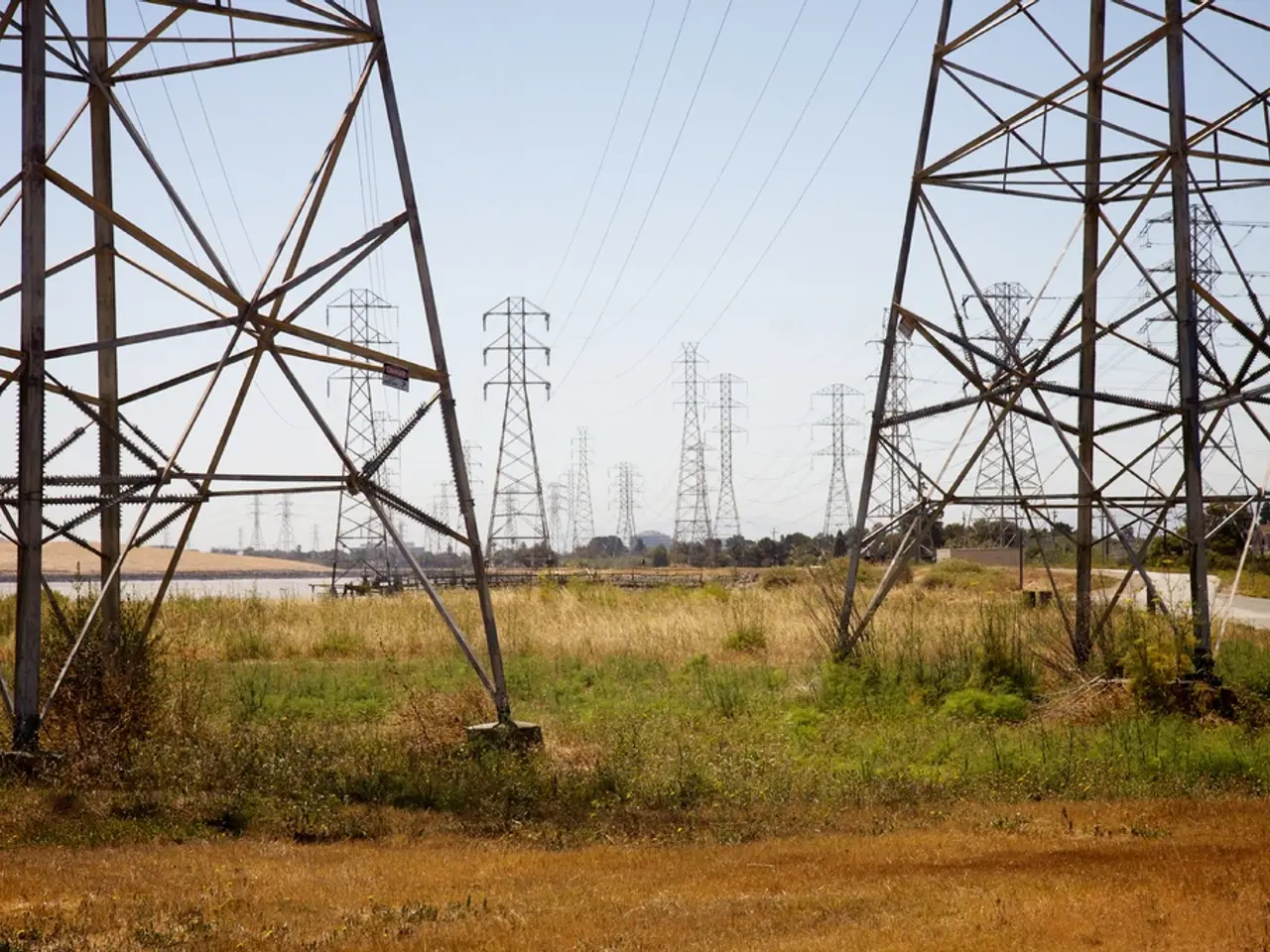Rural Telecommunications Infrastructure Blueprint in Africa: An Overview
In an ambitious stride towards digital equality, solar-powered renewable energy solutions are transforming the landscape of rural telecom infrastructure across Africa. By providing reliable, sustainable, and cost-effective electricity, these solutions are addressing the power supply challenges that have long plagued underserved regions.
One of the key contributions to this shift is the powering of rural telecom towers. In Nigeria, for instance, a joint committee between the Communications Commission and the Rural Electrification Agency aims to deploy renewable energy (solar hubs) at 250 rural telecom towers, with the goal of improving both energy access and telecom connectivity in underserved regions [1].
Enabling off-grid network expansion is another significant advantage. Countries like Sierra Leone are pioneering solar-powered 5G networks, using solar panels combined with battery storage to run telecom infrastructure without dependence on fossil fuel generators [3].
The benefits of this transition extend beyond energy savings. Solar PV systems lower the total cost of ownership by cutting fuel expenses and maintenance costs compared to diesel generators. Innovations like pay-as-you-go solar financing also make adoption viable and scalable [4].
Beyond the practical aspects, reliable power for telecom infrastructure enables consistent internet and mobile services, which are essential for digital learning, healthcare, business, and government services in rural areas. Initiatives in Nigeria emphasize how renewable-powered telecom sites can bridge inequalities and create opportunities for underserved communities [1][2].
Technical improvements are also being made, such as upgrading battery technology from lead-acid to more efficient lithium-ion batteries, further supporting the efficiency and reliability of solar-powered telecom sites [5].
However, challenges remain, such as limited access to electricity grids in rural areas, requiring alternative power sources. To overcome this hurdle, hybrid power systems combining solar, wind, and diesel generators are gaining traction [6].
Securing funding from a mix of public and private sources is essential for expanding successful models in underserved areas [7]. Development banks offer low-interest loans, customized financing options, and technical guidance for rural connectivity projects [8]. Private investment supports growth and innovation in rural telecom projects, with a focus on projects with solid revenue plans and clear community advantages [9].
Local communities also play a crucial role in the maintenance and sustainability of telecom infrastructure through labour, security, and communication efforts [10]. Navigating regulatory requirements involves working closely with national telecommunications authorities and local governments [11].
Wireless technologies like TV White Space (TVWS) and point-to-multipoint (PtMP) systems are solutions for connecting remote areas [12]. However, rural areas in Africa still face limited mobile and high-speed internet coverage compared to urban areas [13].
Modular tower systems and simplified base station hardware reduce upfront costs and installation times [14]. Yet, remote locations with tough terrain and long distances drive up deployment costs and complicate access [15]. A lack of extensive fiber networks forces operators to rely on expensive options like satellite links [16].
Successful examples of this transformation can be seen in countries like South Africa, where telecom development success involves partnerships between government bodies and private companies [17]. As these initiatives continue to grow and evolve, the digital divide between rural and urban Africa may finally begin to close.
References: [1] Communications Week Africa. (2021). Nigeria to deploy renewable energy at 250 rural telecom towers. Retrieved from https://www.communicationsweekafrica.com/nigeria-to-deploy-renewable-energy-at-250-rural-telecom-towers/ [2] IT News Africa. (2021). How solar-powered telecom sites can bridge inequalities in Africa. Retrieved from https://www.itnewsafrica.com/2021/06/how-solar-powered-telecom-sites-can-bridge-inequalities-in-africa/ [3] Energy Live News. (2021). Sierra Leone pioneers solar-powered 5G networks. Retrieved from https://www.energylivenews.com/articles/2021/05/12/sierra-leone-pioneers-solar-powered-5g-networks [4] Rural Electrification Agency. (2021). Nigeria's rural electrification efforts leverage solar PV and hybrid solar-diesel systems. Retrieved from https://reanigeria.org/news/nigerias-rural-electrification-efforts-leverage-solar-pv-and-hybrid-solar-diesel-systems/ [5] Renewable Energy World. (2021). Lithium-ion batteries support the efficiency and reliability of solar-powered telecom sites. Retrieved from https://www.renewableenergyworld.com/articles/2021/05/lithium-ion-batteries-support-the-efficiency-and-reliability-of-solar-powered-telecom-sites/ [6] African Review. (2021). Hybrid power systems gaining traction in rural African telecom infrastructure. Retrieved from https://www.africanreview.com/technology/hybrid-power-systems-gaining-traction-in-rural-african-telecom-infrastructure/ [7] IT News Africa. (2021). Securing funding for rural telecom development in Africa. Retrieved from https://www.itnewsafrica.com/2021/06/securing-funding-for-rural-telecom-development-in-africa/ [8] African Development Bank. (2021). Development banks offer low-interest loans and technical guidance for rural connectivity projects. Retrieved from https://www.afdb.org/en/news-and-events/article/2021/african-development-bank-to-support-solar-powered-telecom-towers-in-nigeria-17162 [9] IT News Africa. (2021). Private investment in rural telecom projects in Africa. Retrieved from https://www.itnewsafrica.com/2021/06/private-investment-in-rural-telecom-projects-in-africa/ [10] Communications Week Africa. (2021). Local communities contribute to the maintenance and sustainability of telecom infrastructure. Retrieved from https://www.communicationsweekafrica.com/local-communities-contribute-to-the-maintenance-and-sustainability-of-telecom-infrastructure/ [11] African Review. (2021). Navigating regulatory requirements in rural African telecom development. Retrieved from https://www.africanreview.com/technology/navigating-regulatory-requirements-in-rural-african-telecom-development/ [12] IT News Africa. (2021). Wireless technologies for connecting remote areas in Africa. Retrieved from https://www.itnewsafrica.com/2021/06/wireless-technologies-for-connecting-remote-areas-in-africa/ [13] African Review. (2021). Limited mobile and high-speed internet coverage in rural Africa. Retrieved from https://www.africanreview.com/technology/limited-mobile-and-high-speed-internet-coverage-in-rural-africa/ [14] Renewable Energy World. (2021). Modular tower systems and simplified base station hardware for rural telecom infrastructure. Retrieved from https://www.renewableenergyworld.com/articles/2021/05/modular-tower-systems-and-simplified-base-station-hardware-for-rural-telecom-infrastructure/ [15] IT News Africa. (2021). Remote locations with tough terrain and long distances complicate rural telecom deployment. Retrieved from https://www.itnewsafrica.com/2021/06/remote-locations-with-tough-terrain-and-long-distances-complicate-rural-telecom-deployment/ [16] African Review. (2021). A lack of extensive fiber networks forces operators to rely on expensive satellite links. Retrieved from https://www.africanreview.com/technology/a-lack-of-extensive-fiber-networks-forces-operators-to-rely-on-expensive-satellite-links/ [17] IT News Africa. (2021). Partnerships between government bodies and private companies drive South Africa's telecom development success. Retrieved from https://www.itnewsafrica.com/2021/06/partnerships-between-government-bodies-and-private-companies-drive-south-africas-telecom-development-success/
- Venture capital and private investment play a significant role in growing rural telecom projects, focusing on projects with robust revenue plans and clear community benefits.
- Policy-and-legislation and regulations, including working closely with national telecom authorities and local governments, are essential in navigating the complex requirements of rural African telecom development.
- Wealth-management organizations offer customized financing options and technical guidance to rural connectivity projects, contributing to the expansion of successful models in underserved areas.
- Technology improvements like upgrading battery technology from lead-acid to lithium-ion batteries and advanced wireless systems (TV White Space and point-to-multipoint) further support the efficiency and reliability of solar-powered telecom sites.
- Sports news, such as updates on the Premier League, Serie A, LaLiga, or the Champions League, can now be accessed in rural Africa due to the expansion and improvement of telecom infrastructure.
- General news and personal finance resources are now reachable for a broader audience due to the proliferation of consistent internet and mobile connectivity in rural Africa.
- The education-and-self-development sector also benefits from the increased access to online resources, enabling students to have remote learning opportunities and professionals to further themselves through e-training programs.
- Financing solutions like pay-as-you-go solar models make the adoption of solar-powered telecom sites affordable and scalable, adapting to the budgets of disadvantaged regions.
- Politics plays a role in facilitating partnerships between government bodies and private companies, working towards the common goal of reducing the digital divide in rural Africa.




